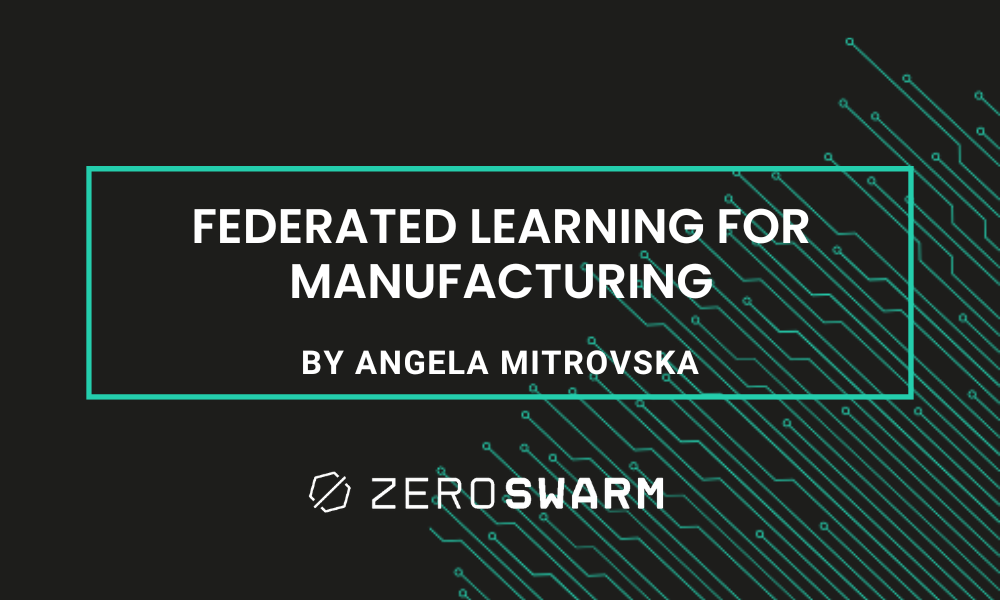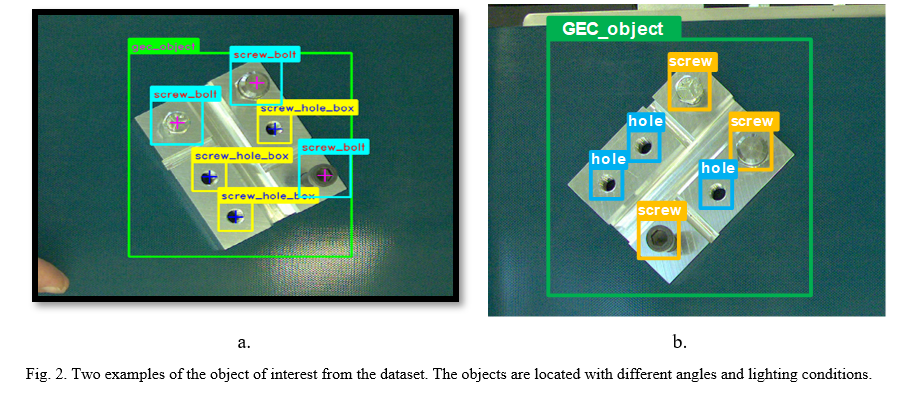Federated Learning for Manufacturing

Modern manufacturing and production processes rely on automated quality assurance and predictive maintenance to achieve better accuracy, reliability and competitiveness [1]. Advancements in Machine Learning (ML) are pushing the boundaries of what is possible in automation, enabling entirely automated systems for quality assurance and predictive maintenance [1, 2].
ML algorithms utilize data from diverse sources, including machines, cameras and sensors, to make critical decisions within the manufacturing process [3]. To improve the accuracy of their algorithms, manufacturing companies often require sharing data between different production sites.
Training an ML model on data originating from two or more production sites, typically involves transferring the data to a shared central location, where the training can take place on the aggregated data. The centralization of data not only poses risks to privacy of potential customers, but also requires the transfer of all data to a central location, which can be a time-consuming and resource-intensive process [4].

What is Federated Learning?
Federated Learning (FL) [5] is a distributed ML method, that addresses these challenges, by allowing the training of ML models at the location where the data is stored, and only the model parameter updates are shared to a central server for aggregation.
FL enables the utilization of data from different sources, such as geo-distributed production sites of the same company, different machines in the same factory, or even competing companies, while allowing the participants to keep the privacy-sensitive data on-premises [5, 6].
In industrial applications, FL can enable the training of ML models on larger and more diverse datasets, even when competitive entities may be involved. This in turn produces models with better accuracies, while preserving the privacy of sensitive data. The process of ML model training with FL encompasses several steps where client-server communication is involved, as shown in Fig. 1.
Recent studies have highlighted FL’s effectiveness in industrial ML model training, demonstrating its ability to improve accuracy while maintaining data privacy [4, 7, 8]. Several studies have utilized edge-enabled FL where multiple on-floor devices in the same production site collaborate to train a model, without having to centralize the data. The federated models were found to outperform the models trained locally on a single device [4].
The potential of FL has also been demonstrated in environments where multiple factories (clients) collaborate to train a global object detection model, while preserving the privacy of the data [8]. FL’s effectiveness has been shown to vary depending on the data that is available, as highly imbalanced or diversely distributed datasets can affect the federated models’ performance greatly [6, 8, 9].
Highlight Use-Cases in Industrial Federated Learning
To display the benefits of utilizing FL in industrial environments, we highlight two distinct use-cases: 1) visual inspection for quality assurance in factories with geo-distributed production sites, and 2) predictive maintenance of air pressure systems in Scania trucks. The training of the federated models for both use-cases is done using DLFi [10], the in-house built Distributed Learning Framework at Fraunhofer HHI.

- Visual inspection for Quality Assurance: Utilizing DLFi, a federated ML model based on the modified YOLOv5l (You Only Look Once version 5 large) object detection framework by Ultralytics [11] was trained on images from geo-distributed production sites. The image dataset provided by the Interactive and Cognitive Systems (ICS) group at Fraunhofer HHI, includes objects machined from aluminum or 3D printed from plastic, obtained at two separate locations with different cameras, angles and lightning conditions (as shown on Fig. 2). The diversity of the dataset enabled us to study the impact of the imaging conditions on the models trained using FL. The experiments proved that the performance of the federated and the centralized models is similar, however the federated models validated on the site with more diverse imaging conditions performed worse than the federated models validated on the site with simpler imaging conditions. The utilization of FL not only enabled the collaborative training on diverse data without compromising its privacy, but also reduced the amount of data that needed to be shared between participants.
- Predictive Maintenance of Air Pressure Systems: Utilizing DLFi, a ML model was trained to predict potential failures in Scania trucks’ air pressure systems [12], with data distributed across three sites. The data is composed of inspection results of multiple trucks, which should be kept private to maintain a competitive advantage. As the Scania dataset is imbalanced, we applied an oversampling technique as detailed in [8], to ensure a more balanced dataset for training. By doing this, the performance of federated models matched that of the centralized models, with the added benefit of enhanced privacy through the implementation of Secure Aggregation (SecAgg) in DLFi [13, 14]. The utilization of FL enabled the early detection of potential failures in a distributed manner, allowing for proactive maintenance schedules that can reduce downtime and increase efficiency.
The showcased use-cases illustrate the practical benefits and some limitations of FL, highlighting its potential to transform traditional manufacturing landscapes into intelligent, more resilient networks. As manufacturing processes continue to evolve towards full automation, FL offers the possibility for development of more robust ML models capable of handling increasingly complex tasks while providing data privacy. FL opens the path towards more collaborative, efficient and secure manufacturing, marking a significant step towards realizing the full potential of Industry 4.0.
Want to learn more about these technologies?
If you want to see more Zero-SWARM technologies, learn more here.
You can also learn more about its AAS toolkit and about how Zero-SWARM is helping incident detection in industrial settings.
For more information about Federated Learning for Manufacturing, see following references:
[1] Sundaram S, Zeid A. Artificial Intelligence-Based Smart Quality Inspection for Manufacturing. Micromachines. 2023; 14(3):570. https://doi.org/10.3390/mi14030570
[2] Safari, Pooyan, et al. “Edge Cloud Based Visual Inspection for Automatic Quality Assurance in Production.” 2022 13th International Symposium on Communication Systems, Networks and Digital Signal Processing (CSNDSP). IEEE, 2022
[3] Kovalenko, M.; Przewozny, D.; Eisert, P.; Bosse, S.; Chojecki, P. Data Fusion for Cross-Domain Real-Time Object Detection on the Edge. Sensors 2023, 23, 6138. https://doi.org/10.3390/s23136138
[4] S. Bharti, A. McGibney and T. O’Gorman, “Edge-enabled Federated Learning for Vision based Product Quality Inspection,” 2022 33rd Irish Signals and Systems Conference (ISSC), Cork, Ireland, 2022, pp. 1-6, doi: 10.1109/ISSC55427.2022.9826185
[5] McMahan, B., Moore, E., Ramage, D., Hampson, S., and y Arcas, B. A. “Communication-efficient learning of deep networks from decentralized data.” 2017 Artificial intelligence and statistics (PMLR), 1273-1282
[6] Li, T., Sahu, A. K., Talwalkar, A., & Smith, V. (2020). Federated learning: Challenges, methods, and future directions. IEEE signal processing magazine, 37(3), 50-60
[7] Hegiste, V., Legler, T., Fridman, K., & Ruskowski, M. (2023, September). Federated object detection for quality inspection in shared production. In 2023 Eighth International Conference on Fog and Mobile Edge Computing (FMEC) (pp. 151-158). IEEE
[8] Pruckovskaja, Viktorija, et al. “Federated Learning for Predictive Maintenance and Quality Inspection in Industrial Applications.” arXiv preprint arXiv:2304.11101 (2023)
[9] Kairouz, Peter, et al. “Advances and open problems in federated learning.” Foundations and Trends® in Machine Learning 14.1–2 (2021): 1-210
[10] https://www.hhi.fraunhofer.de/dlfi
[11] https://github.com/ultralytics/yolov5
[12] https://archive.ics.uci.edu/ml/datasets/APS+Failure+at+Scania+Trucks
[13] Mitrovska, A., Safari, P., Ritter, K., Shariati, B., Fischer, J. K.. (2024). “Secure federated learning for Alzheimer’s disease detection.” Frontiers in Aging Neuroscience. doi: 10.3389/fnagi.2024.1324032
[14] P. Safari, B. Shariati, G. Bergk and J. K. Fischer, “Secure Multi-Party Computation and Statistics Sharing for ML Model Training in Multi-domain Multi-vendor Networks,” 2021 European Conference on Optical Communication (ECOC), Bordeaux, France, 2021, pp. 1-4, doi: 10.1109/ECOC52684.2021.9606082
